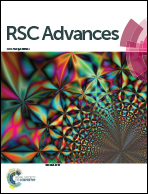Lanthanide metal–organic frameworks based on a 1,2,3-triazole-containing tricarboxylic acid ligand for luminescence sensing of metal ions and nitroaromatic compounds†
Abstract
A series of novel 3D lanthanide metal–organic frameworks based on unsymmetrical 1,2,3-triazole-containing tricarboxylic acid ligand 5-[4-(4-carboxy-phenyl)-[1,2,3]triazol-1-yl]-isophthalic (H3TAIP) has been synthesized under solvothermal conditions. The ligand was synthesized with diethyl-5-azidoisophthalate and 4-ethynyl-benzoic acid ethyl ester through the copper-catalyzed azide alkyne cycloaddition (CuAAC) reaction. Single-crystal X-ray diffraction analyses reveal that these metal–organic frameworks are isostructural. The structures are constructed by bi-nuclear lanthanide metal clusters and TAIP3− ligands and possess flu-3,6-C2/c net with point symbol (42.6)2(44.62.87.102). We explore the luminescence properties of compound 1, which shows the characteristic emission of Tb3+ and exhibits selective detection of 4-nitrophenol and Fe3+ ions in ethanol solution over other nitroaromatic compounds and metal ions.

- This article is part of the themed collection: Zeolites and 3D Porous Solids

 Please wait while we load your content...
Please wait while we load your content...